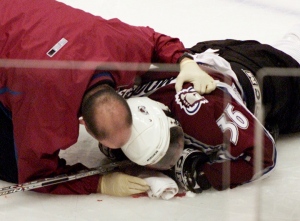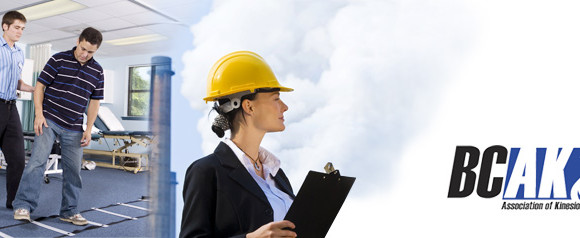News
BCAK/SFU Live Online Seminar: Traumatic Brain Injury – October 28
- On October 28, 2014
- By JR Rehab
- In Industry News, JR Rehab News
 0
0
On October 28, 2014, the Simon Fraser University Biomedical Physiology and Kinesiology Department along with members of the British Columbia Association of Kinesiologists organized a presentation with an emphasis on Traumatic Brain Injury and Work.
One of our outstanding OTs, Jill Olson, was invited to cover topics that included:
· Basic brain anatomy and cognitive function
· Cognitive domains and factors impacting cognition
· Roles and scope of various rehabilitation team members
· How pacing and grading activities supports success
Given Jill’s areas of interest and expertise in mild traumatic brain injury and case management of catastrophic injury, there was a great deal of information to share with the audience. The feedback on Jill’s presentation went beyond expected and many viewers report they will be able to apply knowledge and strategies in their academic and clinical endeavours.
Blood test offers swifter, safer diagnosis of sport brain injury
- On March 21, 2014
- By JR Rehab
- In Industry News, News
 0
0

Colorado Avalanche forward Steve Moore was forced to quit hockey 10 years ago after the Canucks’ Todd Bertuzzi punched him, leaving him with a concussion and a fractured neck.
Raised levels of nerve cell protein a marker of concussion
Thomson Reuters Posted: Mar 14, 2014 8:37 AM ET Last Updated: Mar 14, 2014 8:39 AM ET
Swedish researchers say they have devised a blood test that could better diagnose sports-related brain injuries and prevent American football, rugby and ice hockey players returning to the field in danger.
In findings from a study of ice hockey players, the researchers said their method can show just an hour after a head injury how severe the concussion is, whether there is a risk of long-term symptoms, and when the player can return to the sport.
“In ice hockey and other contact sports, repeated concussions are common, where the brain has not finished healing after the first blow,” said Henrik Zetterberg of the Sahlgrenska Academy at the University of Gothenburg, who led the study.
“This kind of injury is particularly dangerous, but there have not been any methods for monitoring how a concussion in an athlete heals.”
A growing body of scientific evidence, much of it from studies of former American football players and boxers, suggests repeated head knocks such as in contact sports can cause chronic traumatic encephalopathy, a brain condition that can lead to loss of cognitive function, dementia, aggression and depression.
While mild concussions don’t generally cause loss of consciousness, they can induce other symptoms such as dizziness, nausea, trouble concentrating, memory problems and headaches. Severe concussions can cause a loss of consciousness. Most concussions get better in days or weeks, but some patients can suffer symptoms more than a year after injury.
The National Football League in the United States agreed in August to pay $765 million US to settle a lawsuit brought by thousands of former players, many suffering from dementia and health problems. They accused the league of hiding the dangers of brain injury while profiting from the sport’s violence.
- Concussion guide for doctors provides 6-step recovery plan
- Concussion recovery delayed by mental activity, study shows
- Concussions: What to watch for
- Concussions in young athletes need ‘to be taken seriously’
“Concussions are a growing international problem,” said Zetterberg. “The stakes for the individual athlete are high, and the list of players forced to quit with life-long injury is getting ever longer.”
Zetterberg’s team examined all the players in the Swedish Hockey League and found that between September and December of the 2012/2013 season alone, 35 of 288 players had had a concussion. In three cases, it was so severe that the player was knocked unconscious.
For the study, which was published on Thursday in the journal JAMA Neurology, the players who had a concussion were asked to provide repeated blood samples, initially directly after the concussion and then also during the following days.
The results were compared with the pre-season samples from two full teams, and the scientists found that having raised levels of a nerve cell protein called tau in the blood was a marker of concussion.
By measuring tau levels in regular tests, the researchers could say how severe the concussion was just one hour after the injury, and could predict with a high level of certainty which players would have long-term symptoms and needed to rest longer.
Yelverton Tegner, a researcher at Lulea University of Technology and a team doctor for the Swedish national women’s football team, who also worked on the study, said the ultimate aim was “to have a working kit that can be used for diagnostics in hospitals, and perhaps also at rink-side or in stadiums”, for use immediately after a player is concussed.
Zetterberg said the same test could also be used in general emergency medical care to diagnose brain damage from concussions, regardless of how they happened.
Sleep ‘cleans’ the brain of toxins
- On October 25, 2013
- By JR Rehab
- In Blog, Industry News, News
 0
0
By James Gallagher Health and science reporter, BBC News

The brain uses sleep to wash away the waste toxins built up during a hard day’s thinking, researchers have shown.
The US team believe the “waste removal system” is one of the fundamental reasons for sleep.
Their study, in the journal Science, showed brain cells shrink during sleep to open up the gaps between neurons and allow fluid to wash the brain clean.
They also suggest that failing to clear away some toxic proteins may play a role in brain disorders.
One big question for sleep researchers is why do animals sleep at all when it leaves them vulnerable to predators?
It has been shown to have a big role in the fixing of memories in the brain and learning, but a team at the University of Rochester Medical Centre believe that “housework” may be one of the primary reasons for sleep.
“The brain only has limited energy at its disposal and it appears that it must choose between two different functional states – awake and aware or asleep and cleaning up,” said researcher Dr Maiken Nedergaard.
“You can think of it like having a house party. You can either entertain the guests or clean up the house, but you can’t really do both at the same time.”
Plumbing
Their findings build on last year’s discovery of the brain’s own network of plumbing pipes – known as the glymphatic system – which carry waste material out of the brain.
Scientists, who imaged the brains of mice, showed that the glymphatic system became 10-times more active when the mice were asleep.
Cells in the brain, probably the glial cells which keep nerve cells alive, shrink during sleep. This increases the size of the interstitial space, the gaps between brain tissue, allowing more fluid to be pumped in and wash the toxins away.
Dr Nedergaard said this was a “vital” function for staying alive, but did not appear to be possible while the mind was awake.
She told the BBC: “This is purely speculation, but it looks like the brain is losing a lot of energy when pumping water across the brain and that is probably incompatible with processing information.”
She added that the true significance of the findings would be known only after human studies, but doing similar experiments in an MRI machine would be relatively easy.

Commenting on the research Dr Neil Stanley, an independent sleep expert, said: “This is a very interesting study that shows sleep is essential downtime to do some housekeeping to flush out neurotoxins.
“There is good data on memory and learning, the psychological reason for sleep. But this is the actual physical and chemical reason for sleep, something is happening which is important.”
Dr Raphaelle Winsky-Sommerer, a lecturer in sleep at Surrey University, said: “It’s not surprising, our whole physiology is changing during sleep.
“The novelty is the role of the interstitial space, but I think it’s an added piece of the puzzle not the whole mechanism.
“The significance is that, yet again, it shows sleep may contribute to the restoration of brain cell function and may have protective effects.”
Many conditions which lead to the loss of brain cells such as Alzheimer’s or Parkinson’s disease are characterised by the build-up of damaged proteins in the brain.
The researchers suggest that problems with the brain’s cleaning mechanism may contribute to such diseases, but caution more research is needed.
The charity Alzheimer’s Research UK said more research would be needed to see whether damage to the brain’s waste clearance system could lead to diseases like dementia, but the findings offered a “potential new avenue for investigation”.
Neuroplasticity and Education: Strengthening the Connection Conference
- On October 08, 2013
- By Kevin Loades
- In Industry News, JR Rehab News, News
 0
0
Educators, parents, psychologists, counsellors, speech language pathologists, occupational therapists, Faculty of Education students and anyone interested in the connections between the fields of education and neuroscience are welcome to register for this amazing conference and lineup of speakers.
JR Rehab, in conjunction with Cogmed will be exhibiting!
Eye on Rehab Summer 2013 Newsletter
- On August 23, 2013
- By JR Rehab
- In JR Rehab News, News
 0
0
JR’s Work Ability Evaluation
 As therapists, we often have clients who are not achieving return to work or physical rehabilitation goals and we are left searching for answers as to why? As insurance providers, the consequences of a customer not meeting conventional and expected rehabilitation objectives can be significant and therefore decisions of how to best allocate funds become paramount.
As therapists, we often have clients who are not achieving return to work or physical rehabilitation goals and we are left searching for answers as to why? As insurance providers, the consequences of a customer not meeting conventional and expected rehabilitation objectives can be significant and therefore decisions of how to best allocate funds become paramount.
Is there a cost effective way to gain insight into the issues that are preventing these clients from becoming success stories?
In this Issue:
Brain stimulation may aid stroke recovery: study
- On August 23, 2013
- By JR Rehab
- In Industry News, News
 0
0

Dr. Alexander Thiel, director of the stroke unit at the Jewish General Hospital in Montreal, is shown in a handout photo released on Thursday June 27, 2013. THE CANADIAN PRESS/HO-Isabelle Dube, Jewish General Hospital
TORONTO – An experimental procedure that stimulates the brain with electrical pulses through the skull may help people recover the ability to speak after suffering a stroke, researchers say.
Up to 30 per cent of stroke survivors are left with a condition called aphasia, in which they have difficulty understanding language, speaking, reading or writing.
In a small study, Canadian and German researchers tested the effects of transcranial magnetic stimulation, or TMS, on patients recovering from a stroke but left with different degrees of aphasia caused by the damage to their brains.
Twenty-four stroke patients were enrolled in the trial, with 13 getting TMS and 11 treated with a sham procedure. Following the sessions, participants were immediately given speech language therapy.
Patients received 20 minutes of TMS or sham stimulation followed by 45 minutes of speech and language therapy for 10 days, the authors report in the American Heart Association journal Stroke.
Employers must help workers overcome mental health issues
- On August 23, 2013
- By JR Rehab
- In Industry News, News
 0
0

Workplaces must find better ways to help employees overcome mental health issues.
(Alexander Raths/Getty Images/iStockphoto)
It’s a scenario many managers and human resources personnel understand all too well: John, a high-performing employee, experiences a life-changing event and gradually begins demonstrating behavioural and performance issues at work: outbursts of anger, an increased inability to focus, and a noticeable drop in the quality of his work.
John’s disposition is likely linked to a mental health condition, but his manager is unsure of how to offer support. As time passes, John grows more and more distant from the workplace. Eventually, John either goes on disability leave and never returns, or moves on to a new job where the cycle of behaviour begins again at a new company.
JR OT Presenter for Urban Poling Course
- On April 26, 2013
- By JR Rehab
- In Industry News, JR Rehab News, News
 0
0
JR OT, Sue Colbourne, will be one of the Presenters for the Urban Poling Course for Rehabilitation and Wellness Professionals in Victoria on June 22. See the link below to register.
https://www.jrrehab.ca/event/urban-poling-course-for-rehabilitation-and-wellness-professionals-activator-poles/
We’re Hiring OT’s and RA’s!
- On April 25, 2013
- By Kevin Loades
- In JR Rehab News, News
 0
0
JR REHAB SERVICES INC.
Since 1996, JR Rehab has provided rehabilitation services to individuals with brain injuries, soft tissue & orthopedic injuries, chronic pain and mental health issues. We create and implement therapy programs for clients in their home, community centre gym or pool, work place and neighborhood facilities. We currently seek an OT to work with our supportive and dynamic team.
Position: Contract Occupational Therapist
Locations: Abbotsford, Chilliwack, Langley, Surrey
Roles and responsibilities for these positions include:
- Case Management; Community Rehabilitation; Hospital Discharge Planning; Home Assessments; Job Site Evaluations; Cognitive Rehab Therapy
Our OT’s are supported by a team of Rehabilitation Assistants and Kinesiologists.
If you have a minimum of 3 years experience, seek self-employment with flexible hours and want to be part of an energetic and growing company, please forward your resume to:
Ricardo Nuno, Director and Occupational Therapist
Ph: 604.254.0444, Fax 604.254.0447
Email: ricardo.nuno@jrrehab.ca
*****************************************************************
- Implementing the rehabilitation program as directed by the Occupational Therapist
- Instructing patients in self care and activities of daily living
- Assisting in making, modifying, and adapting self-help devices and equipment.
- Wheelchair mobility training
If you have a minimum of 2 years experience, seek self-employment with flexible hours and want to be part of an and growing company, please forward your resume to:
Kevin Loades, Director of Kinesiology Services
Ph: 604.254.0444, Fax 604.254.0447
Email: kevin.loades@jrrehab.ca
For further information on JR Rehab and the services we offer, please visit our website at www.jrrehab.ca.
Driver Medical Fitness Information for Medical Professionals
- On January 18, 2013
- By JR Rehab
- In Industry News, News
 0
0
Ministry of Justice updated their website regarding Driver Medical Fitness. Check out the website below for more information.




